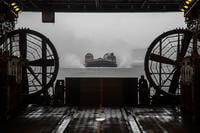
On Saturday, 5 December, my wife and I attended the christening at General Dynamics Electric Boat, in Groton, CT, of the U.S. Navy’s seventh and newest Virginia-class fast attack submarine, PCU (and soon to be USS) Missouri, SSN 780. Listening to the speeches, and watching from the partial comfort of an open tent as her crew stood tall in the drenching, freezing rain on her hull, I was moved to reflect that the chill in the air could also be metaphorical. Last month, DOD stated that in order to balance the fiscal year 2011 budget, the annual construction rate of Virginia-class boats – only just raised at last by Congress to two per year – might be slashed to one per year for some while longer.
This makes absolutely no sense at all.
For much of this decade, the U.S. Submarine Force has faced a steady rise in demand for service coupled with a steady decline in total in-commission numbers. In 2008, the nation’s overworked fast-attack subs were able to take on barely half of the multifaceted missions requested of them. America is getting locked in to having fewer than the 48 fast-attack subs we’ll need during a critical 12-year stretch straddling 2030 – a near-future era when the whole world will surely be facing critical stressors to peace. These include persistent terrorism and failing-state lawlessness on land and at sea, unresolved dangers of nuclear and other WMD proliferation, escalating drug wars, and rising nationalism among armed sub-national ethnic groups and political factions. Military conflict will also arise from the economic catharses, population disruptions, and regime volatilities caused by globalized natural resource shortfalls and rivalries, unpredictable climate changes, resulting floods and droughts and famines, desperate mass human migrations, continued emerging pandemics, plus other interconnected disasters we can’t even name yet.
China is building both diesel and nuclear subs at an aggressive rate, and shows no signs of stopping. Russia, although her navy and arms industry are currently in disarray, is doing what she can to field a modest sized but up-to-date submarine fleet. She cannot be counted out as a worthy peer competitor 20 years from now. Other nations, such as India and Brazil, are working actively to acquire nuclear subs for the first time, while still others, such as Iran, are seeking to strengthen their forces of modern diesels. Increasingly, diesel submarines come equipped with long-submerged-endurance air independent propulsion systems. The immediate post-Cold War peace dividend is definitely a thing of the past. What we have been dragged into now is a relentless, destabilizing arms race which will neither be stopped nor won based on altruistic rhetoric and de facto unilateral disarmament alone.
At a time when so many weapons procurement programs have faced serious delays and cost overruns, the Virginia-class building program continues to surpass contract performance hurdle after hurdle and delivers outstanding operational results underway. While he was Chief of Naval Operations, Admiral Mike Mullen set the Sub Force and submarine industrial base the joint challenge to get the cost of one Virginia down from $2.5 billion to $2 billion in constant 2005 dollars. Only when that happened, he said, could the construction rate of these very fine capital warships be raised to two per year. Since then, I was privileged to visit the GDEB facilities at Groton, CT, and Quonset Point, RI, as well as Northrop Grumman’s Newport News Shipbuilding yard in Virginia. Everybody, from rank-and-file submarine fabricators to top executives, worked with Navy people, from plank owner sub crews to flag officers, to find numerous ways to speed processes and cut costs.
Admiral Mullen’s price benchmark has been met. The Missouri is on target for a record low unit cost, $92 million under budget, with a record fast delivery time, only 5 years and 2 months. This is 9 months sooner than originally expected, and an amazing 38 months faster than first-in-class USS Virginia herself.
Now, DOD and Congress need to keep their end of the bargain made with, and met by, the contractor employees and Sub Force personnel alike. They must continue funding the Virginia class build rate at two per year. The Lexington Institute, a pro-defense think tank in Arlington, VA, stated recently that reducing the acquisition rate to one annually would be “a catastrophic mistake.” I think doing so would also be a gross personal insult to all the Submarine Sailors and submarine shipbuilders – and their families – who braved that wind-driven downpour in the low 40s on Saturday to hear SECNAV Mabus, Senator McCaskill (D-MO), Rep. Joe Courtney (D-CT), Rep. Ike Skelton (D-MO), and the other distinguished speakers who praised their superb efforts on behalf of America’s national security.
-- Joe Buff







